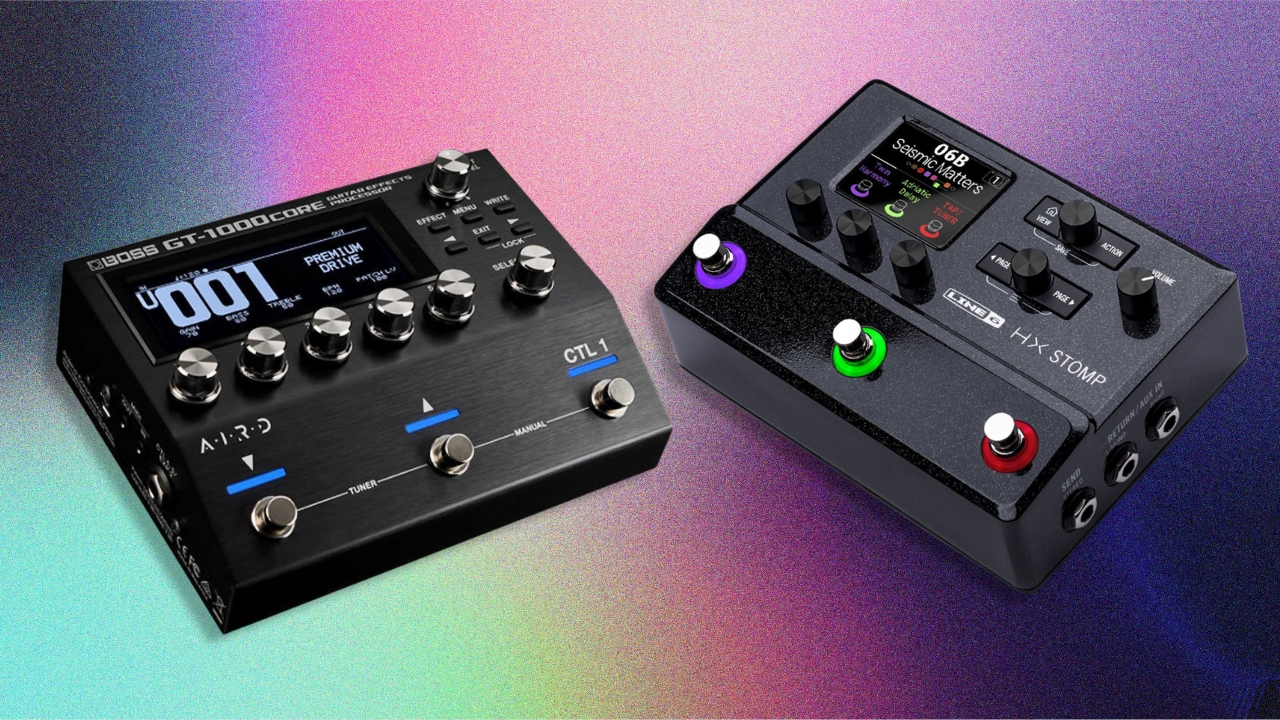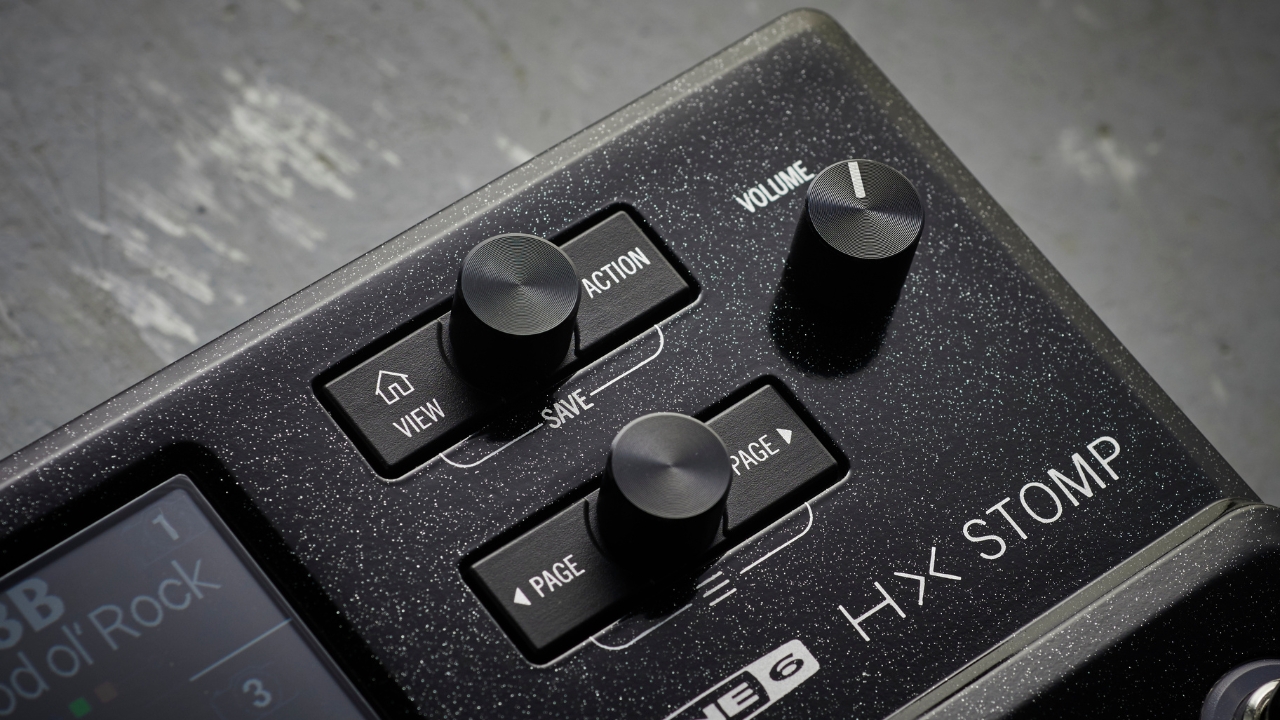Boss GT-1000 Core vs HX Stomp: which amp and effects modeler should you pick?
Which of these pedalboard-sized amp modelers should you choose? We deep dive into the fine details to find out

Whether we like it or not the amp modeler is here to stay. If you're in the former camp - or you're just not quite ready to go fully ampless - then you may well have looked at the options for a unit that will fit on an already existing pedalboard. Many guitarists are opting to go this hybrid route, perhaps using the effects in combination with a tube amp, or the amp modeling with a regular cab for a better playing feel onstage.
Two of the title contenders in the fight for space on your pedalboard are the Boss GT-1000 Core and the Line 6 HX Stomp. Both are compact units that feature amp and effects modeling, plenty of connectivity to integrate into existing setups, and they even look pretty similar with the switch and knob placement.
So which should you get for your rig? It’s a tough choice that’s for sure, but we’re here to lay out the pros and cons, ins and outs, and give you all the info you need to decide which is best for your rig. Let’s get stuck in.
Boss GT 1000 Core vs HX Stomp: At a glance
The GT 1000 Core has 22 amp types and the majority of effects present in the DD-500, MD-500, and RV-500 effects pedals, giving you a huge 140 amp and effect types overall. You can run stereo amps and get 24 ‘blocks’ to play with, so you can craft some seriously complex effects chains.
The HX Stomp comes with a ginormous 88 amp models thanks to multiple updates since its release, as well as 194 effects, 37 speaker cab models, and 16 microphone types. Like the GT 1000 Core, you can run stereo amp setups but you only get 8 blocks to craft your signal chain due to DSP limitations.
Boss GT 1000 Core
- Boss GT-1000CORE review
- Price: $720 / £599
- Amps: 22
- Effects: 118
- Cabs: 7
- IR slots: 16
- Blocks: 24
- Contact: Boss
Line 6 HX Stomp
- Line 6 HX Stomp review
- Price: $599 / £499
- Amps: 88
- Effects: 194
- Cabs: 37
- IR slots:128
- Blocks: 8
- Contact: Line 6
Boss GT 1000 Core vs HX Stomp: Connectivity

With both units being so closely matched, it’s definitely a tough ask to separate them just on hardware alone. Both feature three stompbox-style switches for changing up your sound on the fly, and both are capable of stereo ins and outs. The GT-1000 Core has six knobs plus a master volume for adjusting your sounds and going through menus whereas the HX Stomp has five and a master volume, so again very similar.
There are some slight differences, however. Both units feature MIDI, but the Stomp uses full-size MIDI plugs while the Boss unit has the 3.5mm TRS ins and outs, so you’ll need the appropriate cables if adding MIDI control to your rig. While the HX Stomp has a single effects loop, the GT-1000 Core has two, giving you a little more flexibility when integrating into complex setups.
Get The Pick Newsletter
All the latest guitar news, interviews, lessons, reviews, deals and more, direct to your inbox!

The Stomp has a dedicated headphone output on the side, whereas the GT-1000 Core uses the left main output for headphones. The Boss unit also has two sockets for expression or control pedals to the HX Stomp’s single input. Both units can use splitter cables to connect multiple expression or switches to each slot.
For connecting to your computer, you’ll need a micro USB cable for the GT-1000 Core, the same as which some older phones use, whereas the HX Stomp features a USB-B type input, much like the one you’d find on a printer.
Winner: We’re going to call this one a draw. As near identical units in both size and functionality, there’s very little separating the two here. Apart from the extra fx loop and expression input of the GT-1000 Core, both units are the same in terms of hardware.
Boss GT 1000 Core vs HX Stomp: Build quality & design

These are two major manufacturers so it’s to be expected that both feature a very rugged build quality. They’re designed to be used on pedalboards in a live scenario, so both units feel very robust with a reassuring weight to them. There’s no doubt in our minds that both will put up with plenty of use and abuse on stage.
The HX Stomp is ever so slightly wider, coming in at 178mm to the 1000 Core’s 173mm. Both are a similar height, the Stomp sitting at 66mm and the Boss unit at 65mm including the rubber feet. The HX Stomp has a slightly shorter depth, however, measuring 125mm to the GT 1000 Core’s 135mm. Both will pretty easily fit onto a pedalboard with plenty of room to spare for external effects too.

Everything feels nice and solid in terms of switches, knobs, and buttons. Both units feature smooth turning knobs and responsive buttons that deliver an articulate click when pushed. The GT-1000 Core has a few more buttons you can press when editing via the unit itself, whereas the HX Stomp relies more on combinations of buttons as it has slightly less here.
The buttons are larger on the HX Stomp, however, so some users may find the smaller buttons of the Boss unit a little fiddly. Also, the HX Stomp footswitches have capacitive touch, which means they double as buttons too, useful for selecting an effect when editing patches without having to scroll through your whole effects chain.
In terms of aesthetics, both look very slick, with the brushed grey steel exterior of the GT-1000 Core versus the sparkly black metal of the HX Stomp once again making them very evenly matched. It’s really a matter of taste as to which aesthetic you prefer, but they're not miles apart in terms of design ethos.
Winner: We hate sitting on the fence, but once again it’s too close to call. Both units have a very similar build quality that’s more than rugged enough for life on the road. With such similar looks too it's it’s going to come down to your own unique tastes as to whether you prefer one or the other.
Boss GT 1000 Core vs HX Stomp: Usability

So how easy are they to use? Let’s start with the HX Stomp when using the interface on the pedal itself - we’ll come to the dedicated app later. There’s a definite learning curve here, as you’ll need to memorize certain button presses to save changes or access things like the onboard tuner. However from personal experience it doesn’t take much to nail these, and thanks to the clear screen we found it easy to navigate and edit settings using just the pedal itself.
With the selection of knobs, we found the GT 1000 Core easily navigable as well, however, despite being larger the screen is far less high-resolution than that on the HX Stomp. To be brutally honest it’s a bit like looking at a Gameboy at times and when standing up we had to squint a bit to see what was on the smaller bits of text. That said actually navigating the menus is a touch easier on the GT 1000 Core thanks to the six dedicated buttons, so you don’t have to memorize combo button presses like you do with the HX Stomp.

Despite the obvious difference in quality, both UIs are very similar in terms of how you edit, move around, and adjust your parameters. Both will require some manual diving or video watching when you first get them, but we found the learning curve wasn’t so steep it would put us off either.
Both units have configurable footswitches so you can change what they do and tweak to your personal preference, whether you want certain effects to toggle on and off, or you want to use them to cycle up and down through presets. The capacitive touch switches on the HX Stomp are an interesting choice, and depending on what sort of player you are, can either be really useful, or really annoying. Thankfully if you're in the latter camp you can turn it off via the global settings menu.

Both units also feature a ‘pedalboard’ mode, whereby the switches turn selected effects on and off. However, the HX Stomp goes a significant step further here with its ‘snapshot’ mode. Instead of turning single pedals on and off, you can turn multiple pedals on or off simultaneously and even change amp settings.
Say you wanted a clean tone to start with, then you wanted to add some gain to your amp, a boost, and a chorus pedal, you could execute that with a single button press. You could then change to high gain amp settings, add an overdrive in front of the amp, turn off the chorus and add a reverb and a delay pedal in, again with a single press of the footswitch. It’s incredibly powerful for live playing, and a useful feature in general that adds a lot of flexibility.
Finally, each unit also has an app you can use to edit your tones via a desktop or laptop. As is becoming a running theme between these two, there's not all that much to separate the two, with both the Boss Tone Studio and Helix Control app providing an easier way to adjust your parameters than fiddling around with the small number of buttons on the unit itself.
They're very similar in terms of looks and usability, providing a path that allows you to click on and adjust effects, as well as drag and drop to rearrange your amp or effect blocks. We found both super easy to craft sounds from scratch as well as adjust existing presets and upload your own impulse responses.
Winner: With a better screen and the fantastic snapshot mode, we’re going to have to go with the HX Stomp. While both units are relatively easy to use once you’ve digested the manual, the extra functionality of the HX Stomp sees it nudge ahead on this one.
Boss GT 1000 Core vs HX Stomp: Sound

Now for something a little more subjective. Both units do their tones a little differently and of course, great sound is in the ear of the beholder, so it’s probably best that you listen to some sound demos for yourself to help inform your decision with this one. That said, we’ll do our best to explain what both these units can do.
The HX Stomp features a huge 74 different guitar and bass amp models and tends to focus on recreating real-life amps. You’ve got models of classic Marshall, Vox, and Fender amps which are standard on many modelers, but Line 6 really pushes the boat out with Matchless, Sunn Model T, HiWatt, and Supro models amongst many others giving you a really broad selection of models to choose from.
The GT-1000 Core takes a slightly different approach by creating more unique amp models. There are of course a few classic amps here like your Marshall’s, Fender, and Vox amps, but the majority of the models are of Boss’ creation. It’s an interesting take on amp modeling in general, delivering fresh sounds with their own characteristics voiced specifically for the unit.

Both units deliver fantastic amp tones and while they will need tweaking like most modelers, you won’t fail to get great amp tones out of either. For pure choice, Line 6 very obviously takes the top prize, but we have to say we love the Boss philosophy of not relying upon classic amp models and instead building unique tones.
Line 6 digital effects are renowned for their quality, and you get a huge selection of the company's own effects, alongside a myriad of other famous modeled stompboxes from classic mid-heavy overdrives to world-famous tape echo machines. It’s an astounding collection and thanks to regular updates, one that continues to grow.
Boss are similarly renowned for their effects too, and the GT 1000 Core features the majority of the 500 series reverb, delay, and modulation effects. As you’d expect from Boss these are all top-quality effect algorithms and again there’s a huge amount of choice on offer. The GT 1000 Core also models some classic units but takes the majority of its sounds from existing Boss pedals.
In terms of effects, it's nigh on impossible to separate the two, both have a huge array of choices on offer and give you fantastic quality sounds. If pure choice is what you need then we’d go for the HX Stomp, if you’re already a fan of Boss effects, then the GT 1000 Core might be the better option.
Winner: It’s hard to subjectively say that either unit has ‘better’ sounds so we’ll call this a draw once again. These two amp modelers go about their work in slightly different ways, but both feature a wide range of excellent quality, usable guitar tones.
Boss GT 1000 Core vs HX Stomp: Verdict

We’ve done a few versus pieces and not many have been so closely matched as these two are. Not only do they look strikingly similar but they also operate in much the same way, making it very difficult to choose a clear winner.
That said there was one category where someone just nudged ahead, and that’s in usability and functionality. The Line 6 HX Stomp was far superior here thanks to its snapshot mode, and the regular amp model and effects updates it receives. For playing live or integrating into an existing pedalboard, it’s the natural choice.
It’s a shame that the Boss GT 1000 Core has not had an update since 2022, as it seems like all the ingredients are there to allow it to compete better in terms of functionality with a little tweaking. That said, if you’re a total Boss tone hound and not necessarily fussed about playing live, then it’s a no-brainer to pick the GT 1000 Core, as the amp models and effects are done fantastically well.

Matt is a Junior Deals Writer here at Guitar World. He regularly tests and reviews music gear with a focus on guitars, amps, pedals, modelers, and pretty much anything else guitar-related. Matt worked in music retail for 5 years at Dawsons Music and Northwest Guitars and has written for various music sites including MusicRadar, Guitar Player, Guitar.com, Ultimate Guitar, and Thomann’s t.blog. A regularly gigging guitarist with over 20 years of experience playing live and writing and recording in bands, he's performed everything from jazz to djent, gigging all over the country in more dingy venues than you can shake a drop-tuned guitar at.
“If you’re a young guitar player, that’s money well spent”: John Mayer names the pedal he thinks every young guitar player should consider buying
“An effortless way to customize your TONEX pedals for the stage”: IK Multimedia answers players’ prayers and gives its best-selling TONEX units their biggest upgrade to date – a dedicated editor



![John Mayer and Bob Weir [left] of Dead & Company photographed against a grey background. Mayer wears a blue overshirt and has his signature Silver Sky on his shoulder. Weir wears grey and a bolo tie.](https://cdn.mos.cms.futurecdn.net/C6niSAybzVCHoYcpJ8ZZgE.jpg)

![A black-and-white action shot of Sergeant Thunderhoof perform live: [from left] Mark Sayer, Dan Flitcroft, Jim Camp and Josh Gallop](https://cdn.mos.cms.futurecdn.net/am3UhJbsxAE239XRRZ8zC8.jpg)




